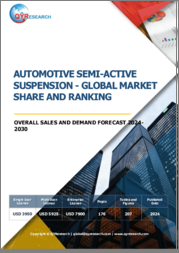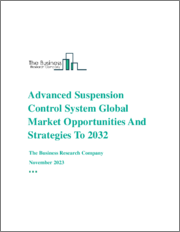
|
시장보고서
상품코드
1620486
자동차 액티브 서스펜션 시스템 시장 기회, 성장 촉진요인, 산업 동향 분석 및 예측(2024-2032년)Automotive Active Suspension System Market Opportunity, Growth Drivers, Industry Trend Analysis, and Forecast 2024 - 2032 |
||||||
세계 자동차 액티브 서스펜션 시스템 시장은 2023년 42억 달러 규모에 달했고, 2024-2032년간 연평균 4.6%의 성장률을 보일 것으로 전망됩니다. 액티브 서스펜션 시스템의 통합으로 자동차 산업은 점점 더 많은 변화를 겪고 있으며, 첨단 기술은 자동차의 성능과 편안함을 향상시키고 있습니다. 기존 서스펜션과 달리 액티브 서스펜션은 액추에이터와 첨단 소프트웨어를 사용하여 각 바퀴를 실시간으로 조정하여 노면 상황에 원활하게 적응할 수 있습니다. 이러한 적응성은 거친 노면에서의 효율적인 승차감과 고속 주행 시 뛰어난 안정성을 제공함으로써 현대 소비자에게 부가가치를 제공합니다. 전기차와 하이브리드 자동차의 채택이 증가하는 것도 액티브 서스펜션 시스템의 성장에 큰 영향을 미치고 있습니다.
이러한 차량은 종종 무게 중심이 낮고 배터리 무게가 무겁게 설계되어 핸들링과 승차감에 독특한 과제를 안고 있습니다. 액티브 서스펜션 기술은 실시간 조정을 통해 이러한 문제를 해결하고, 하중이 가해졌을 때에도 균형 잡힌 승차감과 부드러운 승차감을 보장합니다. 자동차 제조업체들이 전기차 및 하이브리드 모델의 고성능화 및 고유 기능을 추구함에 따라 액티브 서스펜션 시스템은 차별화의 핵심으로 부상하고 있으며, 이 시장 부문의 확대에 박차를 가하고 있습니다. 시장은 유통 채널별로 OEM과 애프터마켓으로 나뉘며, 2023년에는 OEM이 30억 달러 규모 시장을 차지할 것으로 예상되며, OEM은 생산 시 액티브 서스펜션 시스템을 통합하여 호환성과 최적의 성능을 보장함으로써 큰 점유율을 유지하고 있습니다.
프리미엄 자동차 기능에 대한 수요는 지속적으로 증가하고 있으며, OEM 업체들은 편안함과 안정성을 추구하는 소비자의 선호에 부응하기 위해 고급 모델과 전기 모델에 액티브 서스펜션을 적용하는 사례가 증가하고 있습니다. 이러한 추세는 예측 기간 동안 OEM 부문의 성장을 가속할 것으로 예상됩니다. 차량별로는 승용차와 상용차가 있으며, 2023년 승용차가 62%의 점유율을 차지할 것으로 예상됩니다. 승차감과 안전성 향상에 대한 소비자 수요는 특히 고급 승용차와 전기 승용차에서 액티브 서스펜션의 채택을 촉진하고 있습니다. 자동차 제조업체들은 승용차에 이 기술을 탑재하여 핸들링과 승차감을 개선하고 편안하고 안정적인 운전 경험을 원하는 구매자를 충족시키고 있습니다.
| 시장 범위 | |
|---|---|
| 시작 연도 | 2023년 |
| 예측 연도 | 2024-2032년 |
| 시작 금액 | 42억 달러 |
| 예상 금액 | 63억 달러 |
| CAGR | 4.6% |
소비자 취향이 진화함에 따라 이러한 추세는 앞으로도 계속될 것으로 보입니다. 중국 시장은 중요한 성장 촉진요인으로 2023년 매출 점유율의 35%를 차지할 것입니다. 중국에서는 고급차와 전기차에 대한 수요가 높고, 정부의 전기차 도입 지원과 소비자 소득 증가로 인해 액티브 서스펜션 시스템이 탑재된 자동차의 보급이 가속화되고 있습니다. 또한, 세계 트렌드와 규제 우선순위에 맞추어 현지 완성차 업체들도 첨단 서스펜션 기술 통합을 위한 연구개발에 많은 투자를 하고 있습니다. 이처럼 편안함을 추구하는 소비자 수요와 전기자동차에 대한 규제적 지원이 결합되면서 중국은 액티브 서스펜션 시스템에 있어 매우 중요한 시장으로 부상하고 있으며, 산업의 성장 궤도에서 그 중요성이 더욱 커지고 있습니다.
목차
제1장 조사 방법과 조사 범위
제2장 주요 요약
제3장 산업 인사이트
- 생태계 분석
- 공급업체 상황
- 원료 공급업체
- 부품 공급업체
- 제조업체
- 서비스 제공업체
- 판매업체
- 최종 용도
- 이익률 분석
- 비용 내역 분석
- 가격 분석
- 기술 및 혁신 전망
- 주요 뉴스와 이니셔티브
- 규제 상황
- 영향요인
- 성장 촉진요인
- 차량 안정성과 제어성 향상
- 승객 쾌적성과 안전성에 대한 수요 증가
- EV와 고급차 채택 증가
- 센서와 액추에이터 기술 진보
- 산업의 잠재적 리스크와 과제
- 비싼 개발비와 통합 비용
- 복잡한 메인터넌스 요건과 비용
- 성장 촉진요인
- 성장 가능성 분석
- Porter's Five Forces 분석
- PESTEL 분석
제4장 경쟁 구도
- 서론
- 기업 점유율 분석
- 경쟁 포지셔닝 매트릭스
- 전략 전망 매트릭스
제5장 시장 추정·예측 : 시스템별, 2021-2032년
- 주요 동향
- 전자 서스펜션
- 유압식 서스펜션
- 공기압 서스펜션
- 전기 유압식 서스펜션
제6장 시장 추정·예측 : 차량별, 2021-2032년
- 주요 동향
- 승용차
- 상용차
제7장 시장 추정·예측 : 액추에이터별, 2021-2032년
- 주요 동향
- 선형
- 로터리
제8장 시장 추정·예측 : 기술별, 2021-2032년
- 주요 동향
- 세미 액티브
- 풀 액티브
제9장 시장 추정·예측 : 유통 채널별, 2021-2032년
- 주요 동향
- OEM
- 애프터마켓
제10장 시장 추정·예측 : 지역별, 2021-2032년
- 주요 동향
- 북미
- 미국
- 캐나다
- 유럽
- 영국
- 독일
- 프랑스
- 이탈리아
- 스페인
- 러시아
- 북유럽
- 아시아태평양
- 중국
- 인도
- 일본
- 한국
- 호주
- 동남아시아
- 라틴아메리카
- 브라질
- 아르헨티나
- 멕시코
- 중동 및 아프리카
- 아랍에미리트(UAE)
- 사우디아라비아
- 남아프리카공화국
제11장 기업 개요
- Audi(Volkswagen Group)
- Bosch
- Brembo
- BWI
- ClearMotion
- Continental
- Denso
- Hitachi
- Hyundai Mobis
- JTEKT
- KYB
- Magna
- Mando
- Marelli
- Mercedes-Benz
- NIO
- Schaeffler
- Tenneco
- Toyota(Aisin Seiki)
- ZF
The Global Automotive Active Suspension System Market reached a valuation of USD 4.2 billion in 2023, with expectations of growing at a 4.6% CAGR from 2024 to 2032. The integration of active suspension systems is increasingly transforming the automotive industry, enhancing vehicle performance and comfort through advanced technology. Unlike traditional suspensions, active systems utilize actuators and sophisticated software to make real-time adjustments for each wheel, adapting seamlessly to changing road conditions. This adaptability provides efficient rides over rough surfaces and superior stability during high-speed maneuvers, adding value for modern consumers. The rising adoption of electric and hybrid vehicles is a significant factor driving active suspension system growth.
These vehicles, often designed with a lower center of gravity and heavier battery weight, present unique handling and comfort challenges. Active suspension technology addresses these by enabling real-time adjustments, ensuring balance and smoother rides even with added load. As automakers strive for higher performance and unique features in electric and hybrid models, active suspension systems are becoming key differentiators, spurring further expansion in this market segment. The market is divided by sales channel into OEMs and the aftermarket, with OEMs commanding USD 3 billion of the market in 2023. OEMs maintain a substantial share by integrating active suspension systems during production, ensuring compatibility and optimal performance.
The demand for premium automotive features continues to rise, and OEMs are increasingly incorporating active suspensions into luxury and electric models to cater to consumer preferences for enhanced comfort and stability. This trend is expected to bolster the growth of the OEM segment over the forecast period. Segmented by vehicle type, the market includes passenger cars and commercial vehicles, with passenger cars holding a 62% share in 2023. Consumer demand for enhanced ride quality and safety is driving active suspension adoption, particularly in premium and electric passenger vehicles. Automakers are responding by equipping passenger cars with this technology to improve handling and ride smoothness, catering to buyers looking for a comfortable and stable driving experience.
| Market Scope | |
|---|---|
| Start Year | 2023 |
| Forecast Year | 2024-2032 |
| Start Value | $4.2 Billion |
| Forecast Value | $6.3 Billion |
| CAGR | 4.6% |
This trend is set to continue as consumer preferences evolve. China market represents a significant growth driver, holding 35% of the revenue share in 2023. High demand for luxury and electric vehicles in China, alongside government support for EV adoption and increasing consumer incomes, is accelerating the uptake of vehicles equipped with active suspension systems. Local automakers are also investing heavily in R&D to integrate advanced suspension technologies, aligning with global trends and regulatory priorities. This combination of consumer demand for comfort and regulatory support for electric vehicles makes China a pivotal market for active suspension systems, reinforcing its importance in the industry's growth trajectory.
Table of Contents
Chapter 1 Methodology & Scope
- 1.1 Research design
- 1.1.1 Research approach
- 1.1.2 Data collection methods
- 1.2 Base estimates and calculations
- 1.2.1 Base year calculation
- 1.2.2 Key trends for market estimates
- 1.3 Forecast model
- 1.4 Primary research & validation
- 1.4.1 Primary sources
- 1.4.2 Data mining sources
- 1.5 Market definitions
Chapter 2 Executive Summary
- 2.1 Industry 360° synopsis, 2021 - 2032
Chapter 3 Industry Insights
- 3.1 Industry ecosystem analysis
- 3.2 Supplier landscape
- 3.2.1 Raw material supplier
- 3.2.2 Component supplier
- 3.2.3 Manufacturer
- 3.2.4 Service provider
- 3.2.5 Distributor
- 3.2.6 End use
- 3.3 Profit margin analysis
- 3.4 Cost breakdown analysis
- 3.5 Price analysis
- 3.6 Technology & innovation landscape
- 3.7 Key news & initiatives
- 3.8 Regulatory landscape
- 3.9 Impact forces
- 3.9.1 Growth drivers
- 3.9.1.1 Enhanced vehicle stability and control
- 3.9.1.2 Rising demand for passenger comfort and safety
- 3.9.1.3 Increased EV and luxury vehicle adoption
- 3.9.1.4 Advancements in sensor and actuator technology
- 3.9.2 Industry pitfalls & challenges
- 3.9.2.1 High development and integration costs
- 3.9.2.2 Complex maintenance requirements and costs
- 3.9.1 Growth drivers
- 3.10 Growth potential analysis
- 3.11 Porter's analysis
- 3.12 PESTEL analysis
Chapter 4 Competitive Landscape, 2023
- 4.1 Introduction
- 4.2 Company market share analysis
- 4.3 Competitive positioning matrix
- 4.4 Strategic outlook matrix
Chapter 5 Market Estimates & Forecast, By System, 2021 - 2032 ($Mn, Units)
- 5.1 Key trends
- 5.2 Electromagnetic suspension
- 5.3 Hydraulic suspension
- 5.4 Pneumatic suspension
- 5.5 Electro-hydraulic suspension
Chapter 6 Market Estimates & Forecast, By Vehicle, 2021 - 2032 ($Mn, Units)
- 6.1 Key trends
- 6.2 Passenger cars
- 6.3 Commercial vehicles
Chapter 7 Market Estimates & Forecast, By Actuator, 2021 - 2032 ($Mn, Units)
- 7.1 Key trends
- 7.2 Linear
- 7.3 Rotary
Chapter 8 Market Estimates & Forecast, By Technology, 2021 - 2032 ($Mn, Units)
- 8.1 Key trends
- 8.2 Semi-active
- 8.3 Fully active
Chapter 9 Market Estimates & Forecast, By Sales Channel, 2021 - 2032 ($Mn, Units)
- 9.1 Key trends
- 9.2 OEM
- 9.3 Aftermarket
Chapter 10 Market Estimates & Forecast, By Region, 2021 - 2032 ($Mn, Units)
- 10.1 Key trends
- 10.2 North America
- 10.2.1 U.S.
- 10.2.2 Canada
- 10.3 Europe
- 10.3.1 UK
- 10.3.2 Germany
- 10.3.3 France
- 10.3.4 Italy
- 10.3.5 Spain
- 10.3.6 Russia
- 10.3.7 Nordics
- 10.4 Asia Pacific
- 10.4.1 China
- 10.4.2 India
- 10.4.3 Japan
- 10.4.4 South Korea
- 10.4.5 Australia
- 10.4.6 Southeast Asia
- 10.5 Latin America
- 10.5.1 Brazil
- 10.5.2 Argentina
- 10.5.3 Mexico
- 10.6 MEA
- 10.6.1 UAE
- 10.6.2 Saudi Arabia
- 10.6.3 South Africa
Chapter 11 Company Profiles
- 11.1 Audi (Volkswagen Group)
- 11.2 Bosch
- 11.3 Brembo
- 11.4 BWI
- 11.5 ClearMotion
- 11.6 Continental
- 11.7 Denso
- 11.8 Hitachi
- 11.9 Hyundai Mobis
- 11.10 JTEKT
- 11.11 KYB
- 11.12 Magna
- 11.13 Mando
- 11.14 Marelli
- 11.15 Mercedes-Benz
- 11.16 NIO
- 11.17 Schaeffler
- 11.18 Tenneco
- 11.19 Toyota (Aisin Seiki)
- 11.20 ZF

















